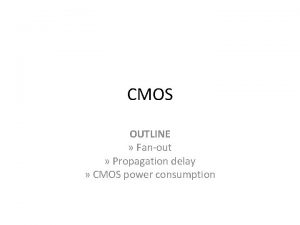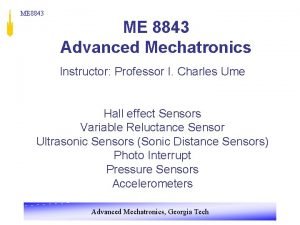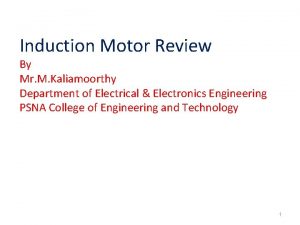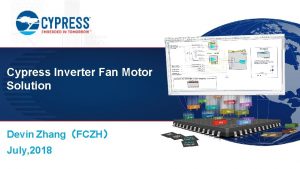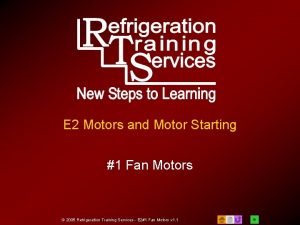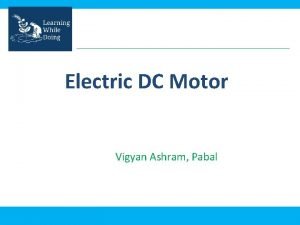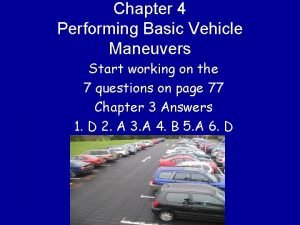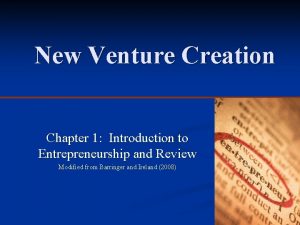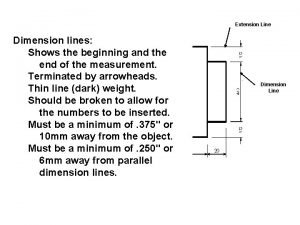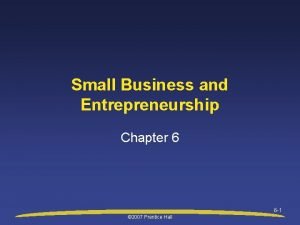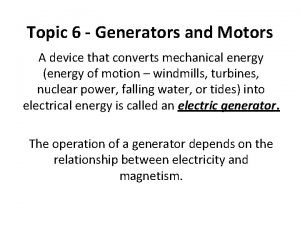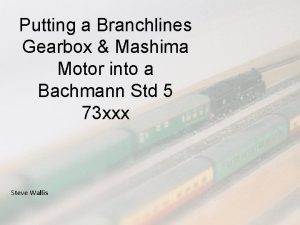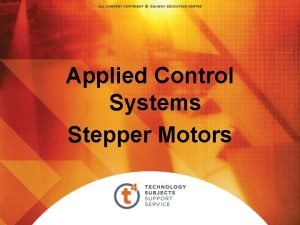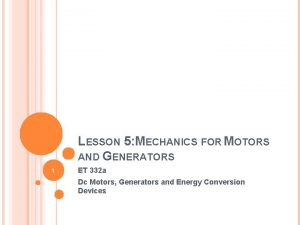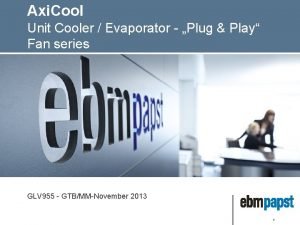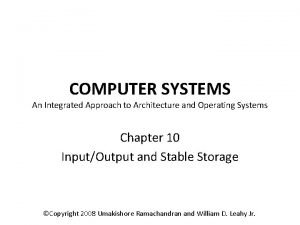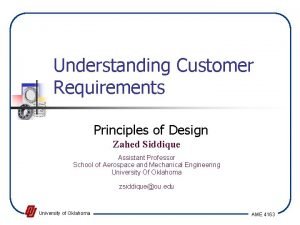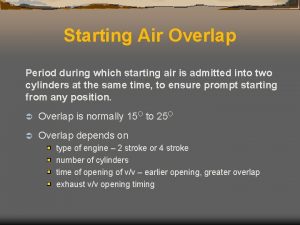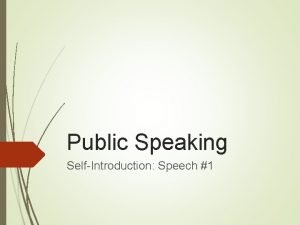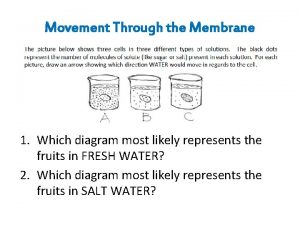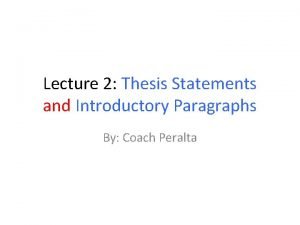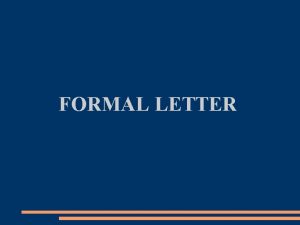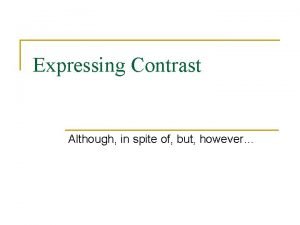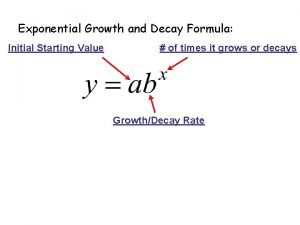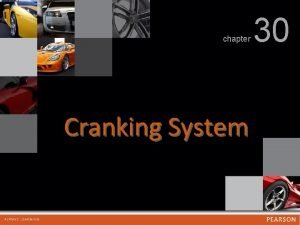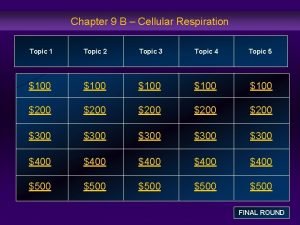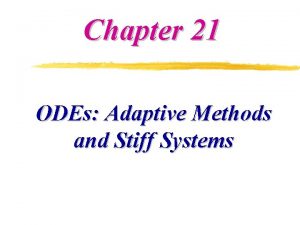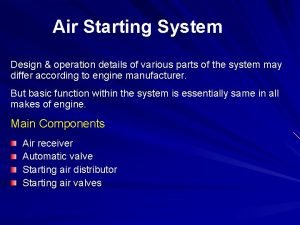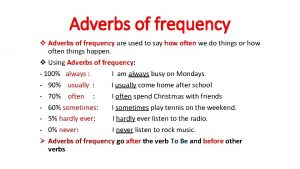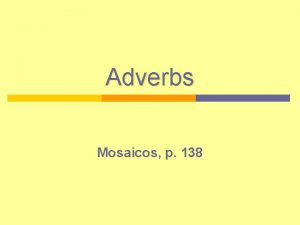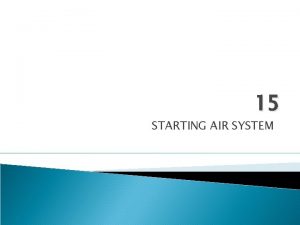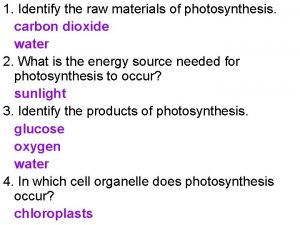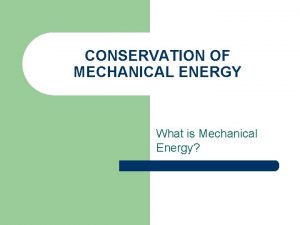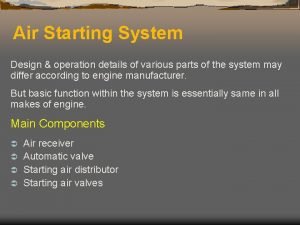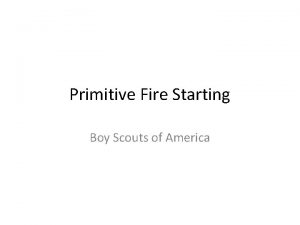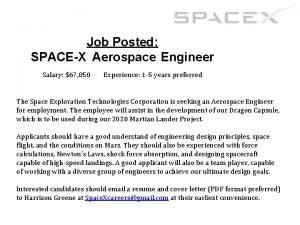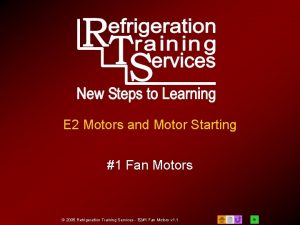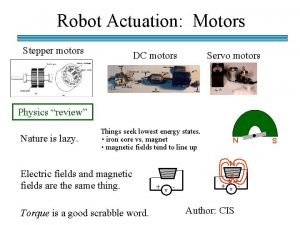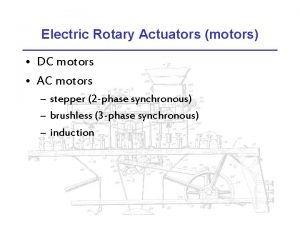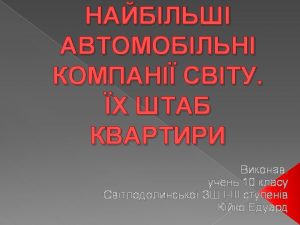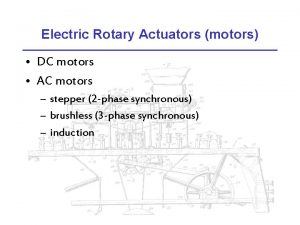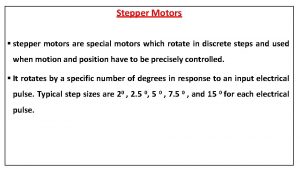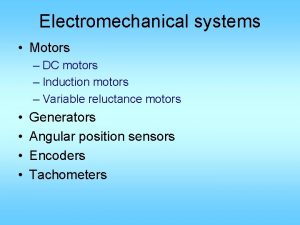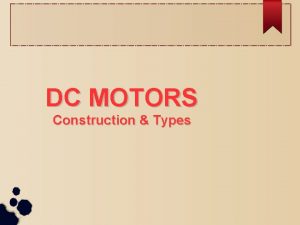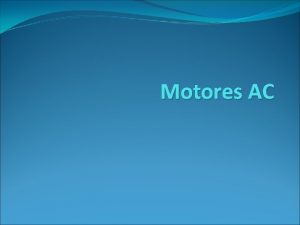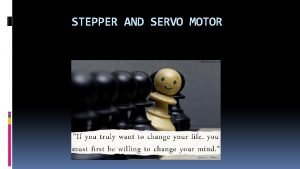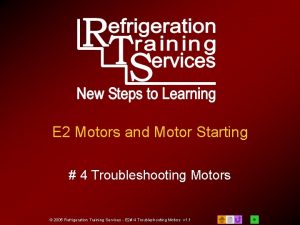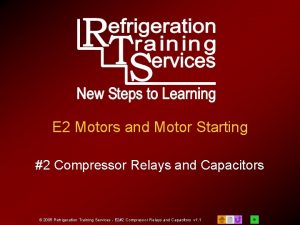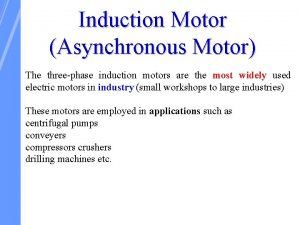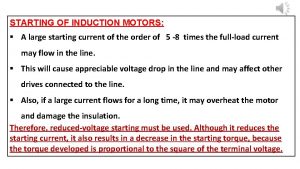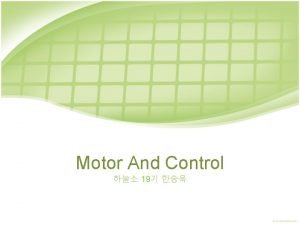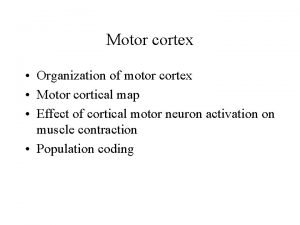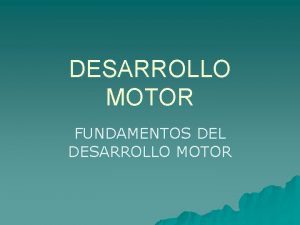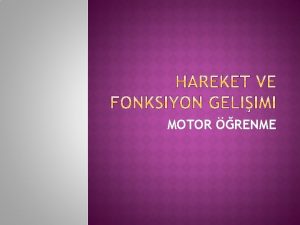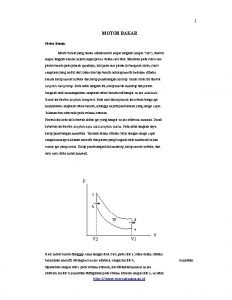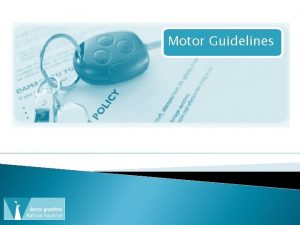E 2 Motors and Motor Starting 1 Fan



































































- Slides: 67

E 2 Motors and Motor Starting #1 Fan Motors © 2005 Refrigeration Training Services - E 2#1 Fan Motors v 1. 1

Basic Electric Motor • Stator – Stationary electromagnet • Rotor – Rotating magnet • Movement of the rotor – Rotates by repulsion and attraction of stator © 2005 Refrigeration Training Services - E 2#1 Fan Motors v 1. 1 2

Exploded View of Motor STATOR (with windings) ROTOR (with shaft) © 2005 Refrigeration Training Services - E 2#1 Fan Motors v 1. 1 3

Two-pole stator motor Stator Rotor (Stationary) (Rotates) Polarity reverses (N to S) on stator N S +_ N S Stator repels & attracts rotor into motion When stator is energized the rotor will make a half turn with each half of current cycle © 2005 Refrigeration Training Services - E 2#1 Fan Motors v 1. 1 4

Second half of cycle + _ S N Stator continues motion by repelling and attracting S N Polarity reverses (N to S) on stator The alternating current now changes direction © 2005 Refrigeration Training Services - E 2#1 Fan Motors v 1. 1 5

Motor Starting All motors need a phase shift to start rotation © 2005 Refrigeration Training Services - E 2#1 Fan Motors v 1. 1 6

Motor Tries to Start Stator Equal and opposite attraction N S Rotor Equal and opposite attraction Power applied to stators Opposite attraction Rotor will NOT move N S Stator © 2005 Refrigeration Training Services - E 2#1 Fan Motors v 1. 1 7

A Phase Shift is Needed Stator N A phase shift causes rotation S Rotor N This phase shift can be caused by: üA shaded pole üA start winding üA capacitor ü 3 separate phases A magnetic field is formed at a slightly different angle S Stator © 2005 Refrigeration Training Services - E 2#1 Fan Motors v 1. 1 8

Shaded-Pole Motors • Low starting torque • Low efficiency • Low cost © 2005 Refrigeration Training Services - E 2#1 Fan Motors v 1. 1 9

Examples of Shaded-Pole Motors © 2005 Refrigeration Training Services - E 2#1 Fan Motors v 1. 1 10

Starting a Shaded-Pole Motor • Each pole has a copper band attached – The shaded-pole provides the phase shift needed to start rotation • Usually impedance protected – A stalled blade will not cause burned windings © 2005 Refrigeration Training Services - E 2#1 Fan Motors v 1. 1 11

Rotation toward the Shaded Pole N S N © 2005 Refrigeration Training Services - E 2#1 Fan Motors v 1. 1 S 12

Shaded-Pole Motor Wiring BLACK GREEN © 2005 Refrigeration Training Services - E 2#1 Fan Motors v 1. 1 LINE GROUND 13

Changing Motor Rotation • Shaded-pole motors can be reversed: – First, turn stator around – Second, turn blade around © 2005 Refrigeration Training Services - E 2#1 Fan Motors v 1. 1 14

Interesting Motor Fact Motor efficiency: A 100 watt 50% efficient motor will put out 50 watts of work, and 50 watts of heat. © 2005 Refrigeration Training Services - E 2#1 Fan Motors v 1. 1 15

Shaded-pole © 2005 Refrigeration Training Services - E 2#1 Fan Motors v 1. 1 C-frame Motor 16

To Reverse Rotation Turn Stator Around ` ` © 2005 Refrigeration Training Services - E 2#1 Fan Motors v 1. 1 17

Rotation is now reversed Turn fan blade around ` © 2005 Refrigeration Training Services - E 2#1 Fan Motors v 1. 1 18

Multi-speed Shaded-Pole Motors • Speed depends on winding resistance – Low speed: most resistance – High speed: least resistance • Motor speed is based on where power is connected into the winding Common High Speed Medium Speed © 2005 Refrigeration Training Services - E 2#1 Fan Motors v 1. 1 Low Speed 19

Shaded-Pole 3 -Speed Motor Wiring Common Wire is White (115 v) or Black (230 v) BLACK-HIGH BLUE-MED LINE RED-LOW GREEN © 2005 Refrigeration Training Services - E 2#1 Fan Motors v 1. 1 GROUND 20

Split Phase Motors • Have two separate windings, a run and a start • The start winding provides the phase shift for starting • More efficient and have more torque than shaded pole motors © 2005 Refrigeration Training Services - E 2#1 Fan Motors v 1. 1 21

A Split Phase Motor is a Two-pole stator motor … with Start Windings added Start Run TO RUN WINDINGS TO START WINDINGS R Start C S © 2005 Refrigeration Training Services - E 2#1 Fan Motors v 1. 1 22

Start & Run Winding Resistances W IN N DI RU NG C ST AR T NG DI S Ω Ω R VAC DC COM V/ © 2005 Refrigeration Training Services - E 2#1 Fan Motors v 1. 1 23

Windings of a split phase motor © 2005 Refrigeration Training Services - E 2#1 Fan Motors v 1. 1 24

Split Phase Motor This motor needs power to the start winding to start C S START WINDING This motor needs a start winding for a phase shift R RUN WINDING This motor needs power to the run winding to run LINE © 2005 Refrigeration Training Services - E 2#1 Fan Motors v 1. 1 25

Fan Motor with Centrifugal Switch • A mechanical switch is used to de-energize the start winding • The switch is attached to the motor shaft • After the motor starts, centrifugal force opens the switch • The start winding circuit remains open as long as the motor is running © 2005 Refrigeration Training Services - E 2#1 Fan Motors v 1. 1 26

Split Phase Motor with Centrifugal Switch Centrifugal switch opens start winding C S START WINDING R RUN WINDING LINE © 2005 Refrigeration Training Services - E 2#1 Fan Motors v 1. 1 27

Fan Motor with Centrifugal Switch • The next slide is a picture of a fan motor with the motor cover removed • The centrifugal switch is attached to the motor shaft • The switch contacts are attached to the end bell (motor cover) © 2005 Refrigeration Training Services - E 2#1 Fan Motors v 1. 1 28

Motor with Centrifugal Switch Start winding energized Motor Speed Increases Weights shift, disk moves back Before starting, disk pushes bar, closing contacts Contacts Open From Run Winding © 2005 Refrigeration Training Services - E 2#1 Fan Motors v 1. 1 To Start Winding Centrifugal Disk Switch 29

Permanent Split Capacitor Motors • A run capacitor is “permanently” wired into the start winding circuit • The capacitor provides partial voltage to the start winding, during start and run © 2005 Refrigeration Training Services - E 2#1 Fan Motors v 1. 1 30

PSC Motor with run capacitor Low Starting Torque Low to Medium Cost Medium Efficiency © 2005 Refrigeration Training Services - E 2#1 Fan Motors v 1. 1 31

Split Phase Motor + Run Cap = PSC Motor DI IN W T NG DI IN W AR N ST RU NG C S R Run Capacitor © 2005 Refrigeration Training Services - E 2#1 Fan Motors v 1. 1 32

Interesting Motor Fact A PSC motor with a bad run capacitor will act like an overloaded motor © 2005 Refrigeration Training Services - E 2#1 Fan Motors v 1. 1 33

PSC Motor Wiring Diagram BLACK LINE BROWN CAPACITOR GREEN © 2005 Refrigeration Training Services - E 2#1 Fan Motors v 1. 1 GROUND 34

Motor Speeds • The synchronous, or “nominal” speed of a motor can be determined by the number of its poles • The more poles, the lower the speed © 2005 Refrigeration Training Services - E 2#1 Fan Motors v 1. 1 35

Two Pole Motor Windings Courtesy of Copeland 7200 2 = 3600 RPM © 2005 Refrigeration Training Services - E 2#1 Fan Motors v 1. 1 36

Calculating Motor Speeds • One cycle has two current flow reversals • 60 cycles has 120 flow reversals • Speed = (60 Hz x 120 reversals) ÷ Poles Example: 7200 ÷ 2 Motor poles = 3600 RPM © 2005 Refrigeration Training Services - E 2#1 Fan Motors v 1. 1 37

Four Pole Motor 1 1 2 2 4 7200 4 = 1800 RPM 4 3 3 Courtesy of Copeland © 2005 Refrigeration Training Services - E 2#1 Fan Motors v 1. 1 38

Actual Motor Speed • Slippage is the loss of speed from motor load • The actual speed is less than the calculated speed Common motor speeds: Calculated: Actual: 2 Pole motor: 3600 3450 4 Pole motor: 1800 1750 6 Pole motor: 1200 1050 8 Pole motor: 900 850 © 2005 Refrigeration Training Services - E 2#1 Fan Motors v 1. 1 39

Multi-Speed Split Phase Motors • Actually they are “Multi-horsepower” • The windings are tapped so the motor is weaker, running slower under load • Example of a 3 -speed 1/3 HP motor: – High speed is 1/3 HP – Medium speed is 1/4 HP – Low speed is 1/6 HP © 2005 Refrigeration Training Services - E 2#1 Fan Motors v 1. 1 40

Single-Speed PSC Motor DI IN W ST NG DI IN T W AR N RU NG C S R Run Capacitor © 2005 Refrigeration Training Services - E 2#1 Fan Motors v 1. 1 41

Single-Speed PSC Motor DI T AR ST NG DI IN W IN N W RU NG C S R Run Capacitor © 2005 Refrigeration Training Services - E 2#1 Fan Motors v 1. 1 42

Multi-speed PSC Motor High Speed RH DI IN W AR T NG DI IN ST W S Medium Speed N RM RU NG C R Low Speed RL © 2005 Refrigeration Training Services - E 2#1 Fan Motors v 1. 1 43

3 -Speed PSC Motor Wiring Diagram BLACK-HIGH BLUE-MED LINE RED-LOW BROWN GREEN © 2005 Refrigeration Training Services - E 2#1 Fan Motors v 1. 1 GROUND 44

Interesting Motor Fact • Multi-speed motors must be under a load to change speeds – Example: A multi-speed blower removed from the blower compartment will run at high speed, no matter which speed tap is used © 2005 Refrigeration Training Services - E 2#1 Fan Motors v 1. 1 45

PSC 3 -speed Motor Leads for changing motor rotation Run Capacitor Leads Common Wire Low Speed (red) Medium Speed (blue) High Speed (black) © 2005 Refrigeration Training Services - E 2#1 Fan Motors v 1. 1 46

Three Phase Motors • High starting torque • High efficiency • Medium to high cost © 2005 Refrigeration Training Services - E 2#1 Fan Motors v 1. 1 47

Three Phase Motors © 2005 Refrigeration Training Services - E 2#1 Fan Motors v 1. 1 48

Three Phase Motor Starting • No start windings or capacitors needed • High torque because the windings are 120° out of phase © 2005 Refrigeration Training Services - E 2#1 Fan Motors v 1. 1 49

3Ø Motor – Wye Connections L 1 T 1 208 V T 3 T 2 L 2 208 V L 3 © 2005 Refrigeration Training Services - E 2#1 Fan Motors v 1. 1 50

3Ø Motor – Delta Connections T 1 L 1 240 V T 3 T 2 240 V L 3 © 2005 Refrigeration Training Services - E 2#1 Fan Motors v 1. 1 51

Describing Common Motors • Motor descriptions include the following information: – Type – Enclosure – Mounting © 2005 Refrigeration Training Services - E 2#1 Fan Motors v 1. 1 52

Common Motor Types © 2005 Refrigeration Training Services - E 2#1 Fan Motors v 1. 1 53

Motor Enclosure Types • • Open Dripproof Totally enclosed fan cooled © 2005 Refrigeration Training Services - E 2#1 Fan Motors v 1. 1 54

Open Enclosure Types Totally Open Dripproof Note: Prevents direct entry of moisture Clean and Mostly Dry Locations Clean and Dry Locations © 2005 Refrigeration Training Services - E 2#1 Fan Motors v 1. 1 55

Enclosed Type Motors Totally Enclosed Air Over Cooling from system air passing over the motor body Totally Enclosed Fan Cooled Cooling from fan forced air passing over the motor body Totally Enclosed are good for wet and dirty conditions © 2005 Refrigeration Training Services - E 2#1 Fan Motors v 1. 1 56

Motor Mounting • Some of the more common mounts: – Rigid – Cradle – Belly band – Stud – C-frame – Unit bearing © 2005 Refrigeration Training Services - E 2#1 Fan Motors v 1. 1 57

Cradle Mount © 2005 Refrigeration Training Services - E 2#1 Fan Motors v 1. 1 58

Rigid Mount Motor housing is welded to the base © 2005 Refrigeration Training Services - E 2#1 Fan Motors v 1. 1 59

Belly Band Mounting Motor slides into ring. Then band is tightened © 2005 Refrigeration Training Services - E 2#1 Fan Motors v 1. 1 60

Stud Mounts Studs are bolted to fan guard or housing. © 2005 Refrigeration Training Services - E 2#1 Fan Motors v 1. 1 61

Other Motor Mounting Styles C-frame © 2005 Refrigeration Training Services - E 2#1 Fan Motors v 1. 1 Unit bearing 62

Motor Nameplate • Nameplates contain essential information © 2005 Refrigeration Training Services - E 2#1 Fan Motors v 1. 1 63

Motor Nameplate explained © 2005 Refrigeration Training Services - E 2#1 Fan Motors v 1. 1 64

Motor Nameplate wiring diagram © 2005 Refrigeration Training Services - E 2#1 Fan Motors v 1. 1 65

Interesting Motor Facts • An overloaded motor (too small for the job): – Lower speed, amperage above 10% of RLA, and overheating • An under-loaded motor (too big for the job): – Little change in speed, amperage 25% below RLA, and overheating © 2005 Refrigeration Training Services - E 2#1 Fan Motors v 1. 1 66

© 2005 Refrigeration Training Services - E 2#1 Fan Motors v 1. 1 67
 Pony motor starting method diagram
Pony motor starting method diagram Application of synchronous motor
Application of synchronous motor Ee 216
Ee 216 Fanin and fanout in cmos
Fanin and fanout in cmos Electrons flowing
Electrons flowing Nascar motors assembles and sells
Nascar motors assembles and sells Ac motor power formula
Ac motor power formula Inverter fan motor
Inverter fan motor Electric fan wiring diagram philippines
Electric fan wiring diagram philippines Motor unit consists of
Motor unit consists of Motor parts name
Motor parts name Chapter 4 performing basic maneuvers page 28 answer key
Chapter 4 performing basic maneuvers page 28 answer key Creating and starting the venture
Creating and starting the venture Alphabet of lines
Alphabet of lines Kamasutra standing positions
Kamasutra standing positions Chapter 6 entrepreneurship and starting a small business
Chapter 6 entrepreneurship and starting a small business Chapter 6 entrepreneurship and starting a small business
Chapter 6 entrepreneurship and starting a small business Chapter 6 entrepreneurship and starting a small business
Chapter 6 entrepreneurship and starting a small business Derived position
Derived position Roles in a small business
Roles in a small business Generators and motors
Generators and motors Mashima motors and gearboxes
Mashima motors and gearboxes Step motors and control systems
Step motors and control systems Abb ability smart sensor
Abb ability smart sensor Units of power
Units of power Yakshi holding a fly whisk
Yakshi holding a fly whisk Plug and play fan
Plug and play fan Disk scheduling algorithms
Disk scheduling algorithms Thinking of starting a business
Thinking of starting a business Victorian scrapbook
Victorian scrapbook Qualities starting with n
Qualities starting with n Overlap in starting air system
Overlap in starting air system Presentation starting speech
Presentation starting speech Starting materials for cellular respiration
Starting materials for cellular respiration Tag statement
Tag statement How to start the introduction
How to start the introduction 5 formal letter in english
5 formal letter in english However but although
However but although A=pert
A=pert Sturdt
Sturdt Chapter 30 engine starting systems
Chapter 30 engine starting systems Starting materials for cellular respiration
Starting materials for cellular respiration Non self starting heun method
Non self starting heun method Starting a busness
Starting a busness Online checking account simulation
Online checking account simulation Starting air valve diagram
Starting air valve diagram Adverb of frequency formula
Adverb of frequency formula Adverb starting with v
Adverb starting with v Air starting system in marine diesel engine
Air starting system in marine diesel engine Raw materials for photosynthesis
Raw materials for photosynthesis A 193 kg curtain needs to be raised
A 193 kg curtain needs to be raised The starting point in a presentation
The starting point in a presentation Electromagnetic spectrum song lyrics
Electromagnetic spectrum song lyrics Acrostic poem for friendship
Acrostic poem for friendship Small resort business plan
Small resort business plan Olympian gods family tree
Olympian gods family tree Mechanical energy definition
Mechanical energy definition Hexagon agility test score clockwise
Hexagon agility test score clockwise Starting substances in a chemical reaction
Starting substances in a chemical reaction Starting air distributor diagram
Starting air distributor diagram _____ is difficulty in starting a urinary stream.
_____ is difficulty in starting a urinary stream. Components of starting system
Components of starting system Change in energy quick check
Change in energy quick check Primitive fire starting
Primitive fire starting What
What The starting point for measuring longitude
The starting point for measuring longitude Aerospace engineer spacex salary
Aerospace engineer spacex salary Short stories for presentation
Short stories for presentation



